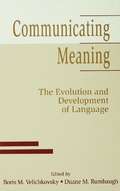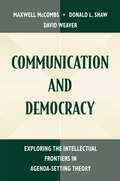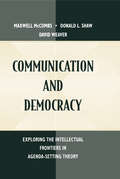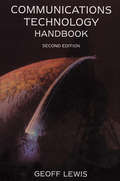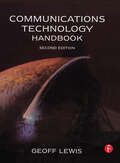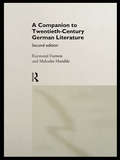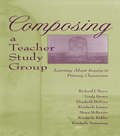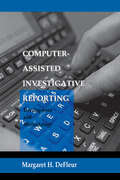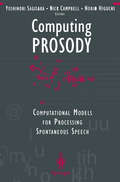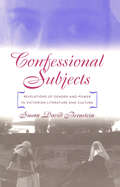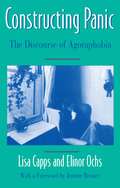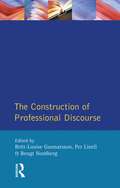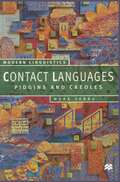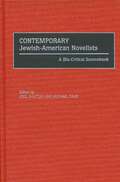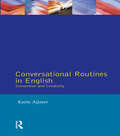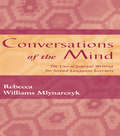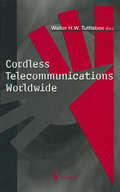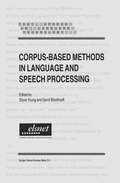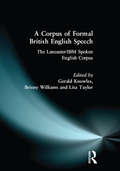- Table View
- List View
Communicating Meaning: The Evolution and Development of Language
by Boris M. Velichkovsky Duane M. RumbaughDealing specifically with the origins and development of human language, this book is based on a selection of materials from a recent international conference held at the Center of Interdisciplinary Research at the University of Bielefeld in Germany. The significance of the volume is that it testifies to paradigmatic changes currently in progress. The changes are from the typical emphasis on the syntactic properties of language and cognition to an analysis of biological and cultural factors which make these formal properties possible. The chapters provide in-depth coverage of such topics as new theoretical foundations for cognitive research, phylogenetic prerequisites and ontogenesis of language, and environmental and cultural forces of development. Some of the arguments and lines of research are relatively well-known; others deal with completely new interdisciplinary approaches. As a result, some of the authors' conclusions are in part, rather counterintuitive, such as the hypothesis that language as a system of formal symbolic transformations may be in fact a very late phenomenon located in the sphere of socio-cultural and not biological development. While highly debatable, this and other hypotheses of the book may well define research questions for the future.
Communication and Democracy: Exploring the intellectual Frontiers in Agenda-setting theory (Routledge Communication Series)
by Maxwell E. McCombs Donald L. Shaw David H. WeaverExciting intellectual frontiers are open for exploration as agenda-setting theory moves beyond its 25th anniversary. This volume offers an intriguing set of maps to guide this exploration over the near future. It is intended for those who are already reasonably well read in the research literature that has accumulated since the publication of McCombs and Shaw's original 1972 Public Opinion Quarterly article. This piece of literature documented the influence of the news media agenda on the public agenda in a wide variety of geographic and social settings, elaborated the characteristics of audiences and media that enhance or diminish those agenda-setting effects, and cataloged those exogenous factors explaining who sets the media's agenda. In the current volume, a provocative set of maps for explicating new levels of agenda-setting theory have been sketched by a new generation of young scholars, launching an enterprise that has significant implications for theoretical research and for the day-to-day role of mass communication in democratic societies. At the first level of agenda setting are agendas of objects--the traditional domain of agenda setting research--represented by an accumulation of hundreds of studies over the past quarter century. At the second level of agenda setting are agendas of attributes--one of the new theoretical frontiers whose aspects are discussed in detail in the opening chapters. Other chapters offer maps of yet other theoretical frontiers, including political advertising agendas and their impact on behavior, the framing of various agendas in the mass media and the differential impact of print and TV, the theoretical role of individual differences in the agenda-setting influence of the news media on the public agenda, methodological advances for determining cause and effect roles in agenda-setting, and the application of agenda-setting theory to historical analysis. This volume is an invitation to others to become active members of the invisible college of agenda-setting scholarship. As such, the goals of this book are threefold: * to introduce a broad set of ideas about agenda-setting; * to enrich the exploration of these ideas by enhancing scholarly dialogue among the members of this invisible college; and * to enhance the discussion of agenda-setting research in seminars and research groups around the world. Agenda-setting has remained a vital and productive area of communication research over a quarter century because it has continued to introduce new research questions into the marketplace of ideas and to integrate this work with other theoretical concepts and perspectives about journalism and mass communication. Understanding the dynamics of agenda- setting is central to understanding the dynamics of contemporary democracy. This book's set of theoretical essays, grounded in the accumulated literature of agenda- setting theory and in the creative insights of young scholars, will help lead the way toward that understanding.
Communication and Democracy: Exploring the intellectual Frontiers in Agenda-setting theory (Routledge Communication Series)
by Maxwell McCombs Donald L. Shaw David WeaverExciting intellectual frontiers are open for exploration as agenda-setting theory moves beyond its 25th anniversary. This volume offers an intriguing set of maps to guide this exploration over the near future. It is intended for those who are already reasonably well read in the research literature that has accumulated since the publication of McCombs and Shaw's original 1972 Public Opinion Quarterly article. This piece of literature documented the influence of the news media agenda on the public agenda in a wide variety of geographic and social settings, elaborated the characteristics of audiences and media that enhance or diminish those agenda-setting effects, and cataloged those exogenous factors explaining who sets the media's agenda. In the current volume, a provocative set of maps for explicating new levels of agenda-setting theory have been sketched by a new generation of young scholars, launching an enterprise that has significant implications for theoretical research and for the day-to-day role of mass communication in democratic societies. At the first level of agenda setting are agendas of objects--the traditional domain of agenda setting research--represented by an accumulation of hundreds of studies over the past quarter century. At the second level of agenda setting are agendas of attributes--one of the new theoretical frontiers whose aspects are discussed in detail in the opening chapters. Other chapters offer maps of yet other theoretical frontiers, including political advertising agendas and their impact on behavior, the framing of various agendas in the mass media and the differential impact of print and TV, the theoretical role of individual differences in the agenda-setting influence of the news media on the public agenda, methodological advances for determining cause and effect roles in agenda-setting, and the application of agenda-setting theory to historical analysis. This volume is an invitation to others to become active members of the invisible college of agenda-setting scholarship. As such, the goals of this book are threefold: * to introduce a broad set of ideas about agenda-setting; * to enrich the exploration of these ideas by enhancing scholarly dialogue among the members of this invisible college; and * to enhance the discussion of agenda-setting research in seminars and research groups around the world. Agenda-setting has remained a vital and productive area of communication research over a quarter century because it has continued to introduce new research questions into the marketplace of ideas and to integrate this work with other theoretical concepts and perspectives about journalism and mass communication. Understanding the dynamics of agenda- setting is central to understanding the dynamics of contemporary democracy. This book's set of theoretical essays, grounded in the accumulated literature of agenda- setting theory and in the creative insights of young scholars, will help lead the way toward that understanding.
Communications Technology Handbook
by Geoff LewisThis is the first point of reference for the communications industries. It offers an introduction to a wide range of topics and concepts encountered in the field of communications technology. Whether you are looking for a simple explanation, or need to go into a subject in more depth, the Communications Technology Handbook provides all the information you need in one single volume.This second edition has been updated to include the latest technology including: Video on DemandWire-less Distribution systemsHigh speed data transmission over telephone linesSmart cards and batteriesGlobal positioning Systems The contents are ordered initially by communications systems. This is followed by an introduction to each topic and goes on to provide more detailed information in alphabetical order. Every section contains an explanation of common terminology, and further references are provided. This approach offers flexible access to information for a variety of readers. Those who know little about communications professionals, the book constitutes a handy reference source and a way of finding out about related technologies. The book addresses an international audience by referring to all systems and standards throughout.This book has been revised to include new sections on: * Video on demand * Wire-less distribution systems * High speed data transmission over telephone lines * Smart cards * Global positioning systems * provides a basic understanding of a wide range of topics* offers a flexible approach for beginners and specialists alike * addresses an international audience by referring to all systems and standards throughout
Communications Technology Handbook
by Geoff LewisThis is the first point of reference for the communications industries. It offers an introduction to a wide range of topics and concepts encountered in the field of communications technology. Whether you are looking for a simple explanation, or need to go into a subject in more depth, the Communications Technology Handbook provides all the information you need in one single volume.This second edition has been updated to include the latest technology including: Video on DemandWire-less Distribution systemsHigh speed data transmission over telephone linesSmart cards and batteriesGlobal positioning Systems The contents are ordered initially by communications systems. This is followed by an introduction to each topic and goes on to provide more detailed information in alphabetical order. Every section contains an explanation of common terminology, and further references are provided. This approach offers flexible access to information for a variety of readers. Those who know little about communications professionals, the book constitutes a handy reference source and a way of finding out about related technologies. The book addresses an international audience by referring to all systems and standards throughout.This book has been revised to include new sections on: * Video on demand * Wire-less distribution systems * High speed data transmission over telephone lines * Smart cards * Global positioning systems * provides a basic understanding of a wide range of topics* offers a flexible approach for beginners and specialists alike * addresses an international audience by referring to all systems and standards throughout
A Companion to Twentieth-Century German Literature
by Raymond Furness Malcolm HumbleContaining entries on over four hundred authors of fiction, poetry and drama from Germany, Austria and Switzerland, this invaluable work of reference presents material of a range and depth that no other book on the subject in English attains. For the second edition, the entries have been updated to include the most recent works of German literature. A number of new entries have been added, dealing in particular with the East German literary scene and the changing literary landscape after reunification. In addition to basic biographical facts, the Companion offers summaries, information on involvement in literary groups and political developments, schools and movements, critical terms and aspects of the other arts, including film.
A Companion to Twentieth-Century German Literature
by Raymond Furness Malcolm HumbleContaining entries on over four hundred authors of fiction, poetry and drama from Germany, Austria and Switzerland, this invaluable work of reference presents material of a range and depth that no other book on the subject in English attains. For the second edition, the entries have been updated to include the most recent works of German literature. A number of new entries have been added, dealing in particular with the East German literary scene and the changing literary landscape after reunification. In addition to basic biographical facts, the Companion offers summaries, information on involvement in literary groups and political developments, schools and movements, critical terms and aspects of the other arts, including film.
Composing a Teacher Study Group: Learning About Inquiry in Primary Classrooms
by Richard J. Meyer With Linda Brown Elizabeth DeNino Kimberly Larson Mona McKenzieThere has been a flurry of writing about teachers as inquirers and researchers as well as books about children as inquirers. This volume brings these two areas together -- teachers and students are inquiring at Ridgeway Elementary School. It demonstrates the importance of thought collectives as forums for student and teacher learning. The children in the primary classrooms in this book are working to understand the world around them and their place in it as literate individuals. Their teachers are studying themselves and the students. No other book describes the way this work affects children, teachers, and the ethos of the school in which the work occurs. In that sense, this book is groundbreaking in that it is an honest portrayal of the joys and sorrows, the successes and the stumbling blocks, the clear vision, and the obfuscating that teachers live as they enact a life of asking questions, being curious, wandering, and wondering. Acknowledging and honoring the many faces of inquiry in schools, this book demonstrates the children's inquiry, their teachers' inquiry, and the place of that inquiry in schools. It lays out the ways in which inquiry is fundamental to teaching and learning in a democracy in which all of the members of the community have a voice in deciding curricular directions and ways of presenting learning. Teachers are presented as thinkers and learners, not merely as technicians enacting others' views of what is to be learned and when. Readers will find teachers dealing with the real issues of life in schools; they will see how teachers can use their existing situations as points of departure for their growth and their students' learning.
Composing a Teacher Study Group: Learning About Inquiry in Primary Classrooms
by Richard J. Meyer With Linda Brown Elizabeth DeNino Kimberly Larson Mona McKenzieThere has been a flurry of writing about teachers as inquirers and researchers as well as books about children as inquirers. This volume brings these two areas together -- teachers and students are inquiring at Ridgeway Elementary School. It demonstrates the importance of thought collectives as forums for student and teacher learning. The children in the primary classrooms in this book are working to understand the world around them and their place in it as literate individuals. Their teachers are studying themselves and the students. No other book describes the way this work affects children, teachers, and the ethos of the school in which the work occurs. In that sense, this book is groundbreaking in that it is an honest portrayal of the joys and sorrows, the successes and the stumbling blocks, the clear vision, and the obfuscating that teachers live as they enact a life of asking questions, being curious, wandering, and wondering. Acknowledging and honoring the many faces of inquiry in schools, this book demonstrates the children's inquiry, their teachers' inquiry, and the place of that inquiry in schools. It lays out the ways in which inquiry is fundamental to teaching and learning in a democracy in which all of the members of the community have a voice in deciding curricular directions and ways of presenting learning. Teachers are presented as thinkers and learners, not merely as technicians enacting others' views of what is to be learned and when. Readers will find teachers dealing with the real issues of life in schools; they will see how teachers can use their existing situations as points of departure for their growth and their students' learning.
Computer-assisted Investigative Reporting: Development and Methodology
by Margaret H. DeFleurConducting computer analyses for the purposes of revealing information of significance to the press represents an extension of one of the most important forms of American journalism into the contemporary era of new technologies. Investigative reporting had its start with the establishment of the metropolitan newspaper during the early decades of the 1900s. At the time, it was a continuation of the evolving tradition of freedom of the press that had characterized American political life since colonial times. As it developed, investigative reporting stressed facts rather than the opinions of the editor or reporter. In turn, that tradition had its own intellectual roots. Today, computer-assisted investigative reporting (CAIR) extends that "marketplace of ideas" into systematic examinations of the electronic records of government. In addition, computer analyses of other kinds of information systematically gathered by journalists can provide the press with insights into trends and patterns unlikely to be revealed by other means. This unique volume addresses procedures and issues in investigative journalism that have not been explained in other publications. It sets forth -- for the first time -- a detailed and specific methodology for conducting computer-assisted investigative analyses of both large and small scale electronic records of government and other agencies. That methodology consists of the logic of inquiry, strategies for reaching valid conclusions, and rules for reporting what has been revealed by the analyses to the public in clear ways. Such systematic methodologies are essential in social and other sciences and the development of a counterpart for investigative journalism has been badly needed. That systematic methodology is developed within a context that explains the origin and major characteristics of those elements that have come together in American society to make computer-assisted investigative reporting both possible and increasingly a part of standard newsroom practices. These include the development of traditional investigative journalism, the evolution of computer technology, the use of computers by government to keep records, the legal evolution of freedom of information laws, the rapid adoption of computers in newsrooms, the increasing importance of precision journalism, and the sharp increase in recent times of computer-assisted investigative reporting by American newspapers both large and small. The issues addressed in this book are discussed in a very readable context with an abundance of examples and illustrations drawn from the real world of journalism as it is practiced daily in newsrooms around the country. Explanations of concepts, principles, and procedures are set forth in layperson's terms that require very little in the way of knowledge of computers or statistical methods.
Computer-assisted Investigative Reporting: Development and Methodology
by Margaret H. DeFleurConducting computer analyses for the purposes of revealing information of significance to the press represents an extension of one of the most important forms of American journalism into the contemporary era of new technologies. Investigative reporting had its start with the establishment of the metropolitan newspaper during the early decades of the 1900s. At the time, it was a continuation of the evolving tradition of freedom of the press that had characterized American political life since colonial times. As it developed, investigative reporting stressed facts rather than the opinions of the editor or reporter. In turn, that tradition had its own intellectual roots. Today, computer-assisted investigative reporting (CAIR) extends that "marketplace of ideas" into systematic examinations of the electronic records of government. In addition, computer analyses of other kinds of information systematically gathered by journalists can provide the press with insights into trends and patterns unlikely to be revealed by other means. This unique volume addresses procedures and issues in investigative journalism that have not been explained in other publications. It sets forth -- for the first time -- a detailed and specific methodology for conducting computer-assisted investigative analyses of both large and small scale electronic records of government and other agencies. That methodology consists of the logic of inquiry, strategies for reaching valid conclusions, and rules for reporting what has been revealed by the analyses to the public in clear ways. Such systematic methodologies are essential in social and other sciences and the development of a counterpart for investigative journalism has been badly needed. That systematic methodology is developed within a context that explains the origin and major characteristics of those elements that have come together in American society to make computer-assisted investigative reporting both possible and increasingly a part of standard newsroom practices. These include the development of traditional investigative journalism, the evolution of computer technology, the use of computers by government to keep records, the legal evolution of freedom of information laws, the rapid adoption of computers in newsrooms, the increasing importance of precision journalism, and the sharp increase in recent times of computer-assisted investigative reporting by American newspapers both large and small. The issues addressed in this book are discussed in a very readable context with an abundance of examples and illustrations drawn from the real world of journalism as it is practiced daily in newsrooms around the country. Explanations of concepts, principles, and procedures are set forth in layperson's terms that require very little in the way of knowledge of computers or statistical methods.
Computing PROSODY: Computational Models for Processing Spontaneous Speech
by Yoshinori Sagisaka Nick Campbell Norio HiguchiThis book presents a collection of papers from the Spring 1995 Work shop on Computational Approaches to Processing the Prosody of Spon taneous Speech, hosted by the ATR Interpreting Telecommunications Re search Laboratories in Kyoto, Japan. The workshop brought together lead ing researchers in the fields of speech and signal processing, electrical en gineering, psychology, and linguistics, to discuss aspects of spontaneous speech prosody and to suggest approaches to its computational analysis and modelling. The book is divided into four sections. Part I gives an overview and theoretical background to the nature of spontaneous speech, differentiating it from the lab-speech that has been the focus of so many earlier analyses. Part II focuses on the prosodic features of discourse and the structure of the spoken message, Part ilIon the generation and modelling of prosody for computer speech synthesis. Part IV discusses how prosodic information can be used in the context of automatic speech recognition. Each section of the book starts with an invited overview paper to situate the chapters in the context of current research. We feel that this collection of papers offers interesting insights into the scope and nature of the problems concerned with the computational analysis and modelling of real spontaneous speech, and expect that these works will not only form the basis of further developments in each field but also merge to form an integrated computational model of prosody for a better understanding of human processing of the complex interactions of the speech chain.
Confessional Subjects: Revelations of Gender and Power in Victorian Literature and Culture
by Susan David BernsteinSusan Bernstein examines the gendered power relationships embedded in confessional literature of the Victorian period. Exploring this dynamic in Charlotte Bronta's Villette, Mary Elizabeth Braddon's Lady Audley's Secret, George Eliot's Daniel Deronda, and Thomas Hardy's Tess of the d'Urbervilles, she argues that although women's disclosures to male confessors repeatedly depict wrongdoing committed against them, they themselves are viewed as the transgressors. Bernstein emphasizes the secularization of confession, but she also places these narratives within the context of the anti-Catholic tract literature of the time. Based on cultural criticism, poststructuralism, and feminist theory, Bernstein's analysis constitutes a reassessment of Freud's and Foucault's theories of confession. In addition, her study of the anti-Catholic propaganda of the mid-nineteenth century and its portrayal of confession provides historical background to the meaning of domestic confessions in the literature of the second half of the century.Originally published in 1997.A UNC Press Enduring Edition -- UNC Press Enduring Editions use the latest in digital technology to make available again books from our distinguished backlist that were previously out of print. These editions are published unaltered from the original, and are presented in affordable paperback formats, bringing readers both historical and cultural value.
Constructing Panic: The Discourse of Agoraphobia
by Lisa Capps Elinor OchsMeg Logan has not been farther than two miles from home in six years. She has agoraphobia, a debilitating anxiety disorder that entraps its sufferers in the fear of leaving safe havens such as home. Paradoxically, while at this safe haven, agoraphobics spend much of their time ruminating over past panic experiences and imagining similar hypothetical situations. In doing so, they create a narrative that both describes their experience and locks them into it. Constructing Panic offers an unprecedented analysis of one patient's experience of agoraphobia. In this novel interdisciplinary collaboration between a clinical psychologist and a linguist, the authors probe Meg's stories for constructions of emotions, actions, and events. They illustrate how Meg uses grammar and narrative structure to create and recreate emotional experiences that maintain her agoraphobic identity. In this work Capps and Ochs propose a startling new view of agoraphobia as a communicative disorder. Constructing Panic opens up the largely overlooked potential for linguistic and narrative analysis by revealing the roots of panic and by offering a unique framework for therapeutic intervention. Readers will find in these pages hope for managing panic through careful attention to how we tell the story of our lives.
The Construction of Professional Discourse
by B. L. Gunnarsson Per Linell Bengt NordbergInternationally, there is increasing research and interest in the processes of the production and reception of texts for specific purposes and in the historical development of genres and registers within Languages for Specific Purposes (LSP), psycholinguistics, sociolinguistics, anthropology and the sociology of science. Studies of professional communication have traditionally been biased towards the written medium and have been carried out with little, if any, connection to LSP. Disciplinary boundaries and interest groupings have thus kept these different approaches to the study of professional communication and interaction separate. The editors of this volume unite these different perspectives and approaches and bring together recent research from linguistics, sociolinguistics, ethnography of communication, anthropology and sociology to provide an up-to-date analysis of different varieties of professional discourse and their historical development. Chapters written by leading exponents in the field deal with the core theoretical issue of how language, written genres and spoken discourse are constructed as a successive and continuous interplay between language and social realities. The volume includes chapters on the moral construction of discourse in the social care profession, the discourse of dispute negotiation, narrative accounts in clinical research, doctor-patient interaction, legal and other kinds of institutional discourse.A key text for students of applied linguistics and sociolinguistics at both advanced, undergraduate and MA levels.
The Construction of Professional Discourse
by B. L. Gunnarsson Per Linell Bengt NordbergInternationally, there is increasing research and interest in the processes of the production and reception of texts for specific purposes and in the historical development of genres and registers within Languages for Specific Purposes (LSP), psycholinguistics, sociolinguistics, anthropology and the sociology of science. Studies of professional communication have traditionally been biased towards the written medium and have been carried out with little, if any, connection to LSP. Disciplinary boundaries and interest groupings have thus kept these different approaches to the study of professional communication and interaction separate. The editors of this volume unite these different perspectives and approaches and bring together recent research from linguistics, sociolinguistics, ethnography of communication, anthropology and sociology to provide an up-to-date analysis of different varieties of professional discourse and their historical development. Chapters written by leading exponents in the field deal with the core theoretical issue of how language, written genres and spoken discourse are constructed as a successive and continuous interplay between language and social realities. The volume includes chapters on the moral construction of discourse in the social care profession, the discourse of dispute negotiation, narrative accounts in clinical research, doctor-patient interaction, legal and other kinds of institutional discourse.A key text for students of applied linguistics and sociolinguistics at both advanced, undergraduate and MA levels.
Contact Languages: Pidgins and Creoles (Macmillan Modern Linguistics)
by Mark SebbaContact Languages: Pidgins and Creoles aims to introduce the reader to the exciting and important field of pidgin and creole studies. The book deals with the linguistic, historical and social aspects of the development of pidgin and creole languages. Detailed case studies of individual pidgins and creoles are based around texts drawn from a range of different types and contexts (mainly contemporary), with discussion and grammatical notes. Chapters are interspersed with exercises to consolidate and develop the reader's understanding.
Contemporary Jewish-American Novelists: A Bio-Critical Sourcebook
by Joel Shatzky Michael TaubSince World War II, Jewish-American novelists have significantly contributed to the world of literature. This reference book includes alphabetically arranged entries for more than 75 Jewish-American novelists whose major works were largely written after World War II. Included are entries for both well-known and relatively obscure novelists, many of whom are just becoming established as significant literary figures. While the volume profiles major canonical figures such as Saul Bellow, Norman Mailer, and Bernard Malamud, it also aims to be more inclusive than other works on contemporary Jewish-American writers. Thus there are entries for gay and lesbian novelists such as Lev Raphael and Judith Katz, whose works challenge the more orthodox definition of Jewish religious and cultural traditions; Art Speigelman, whose controversial ^IMaus^R established a new genre by combining elements of the comic book and the conventional novel; and newcomers such as Steve Stern and Max Apple, who have become more prominent within the last decade. Each entry includes a brief biography, a discussion of major works and themes, an overview of the novelist's critical reception, and a bibliography of primary and secondary sources. A thoughtful introduction summarizes Jewish-American fiction after World War II, and a selected, general bibliography lists additional sources of information.Since World War II, Jewish-American novelists have made numerous significant contributions to contemporary literature. Authors of earlier generations would frequently write about the troubles and successes of Jewish immigrants to America, and their works would reflect the world of European Jewish culture. But like other immigrant groups, Jewish-Americans have become increasingly assimilated into mainstream American culture. Many feel the loss of their heritage and long for something to replace the lost values of the old world.This reference book includes alphabetically arranged entries for more than 75 Jewish-American novelists whose major works were largely written after World War II. Included are entries for both well-known and relatively obscure novelists, many of whom are just becoming established as significant literary figures. While the volume profiles major canonical figures such as Saul Bellow, Norman Mailer, and Bernard Malamud, it also aims to be more inclusive than other works on contemporary Jewish-American writers. Thus there are entries for gay and lesbian novelists such as Lev Raphael and Judith Katz, whose works challenge the more orthodox definitions of Jewish religious and cultural traditions; Art Speigelman, whose controversial ^IMaus^R established a new genre by combining elements of the comic book and the conventional novel; and newcomers such as Steve Stern and Max Apple, who have become more prominent within the last decade. Each entry includes a brief biography, a discussion of major works and themes, an overview of the novelist's critical reception, and a bibliography of primary and secondary sources. A thoughtful introduction summarizes Jewish-American fiction after World War II, and a selected, general bibliography lists additional sources for information.
Conversational Routines in English: Convention and Creativity
by Karin AijmerIt is surprising how much of everyday conversation consists of repetitive expressions such as 'thank you', 'sorry', would you mind?' and their many variants. However commonplace they may be, they do have important functions in communication.This thorough study draws upon original data from the London-Lund Corpus of Spoken English to provide a discoursal and pragmatic account of the more common expressions found in conversational routines, such as apologising, thanking, requesting and offering.The routines studied in this book range from conventionalized or idiomatized phrases to those which can be generated by grammar. Examples have been taken from face-to-face conversations, radio discussions and telephone conversations, and transcription has been based upon the prosodic system of Crystal (1989).An extensive introduction provides the theory and methodology for the book and discusses the criteria for fixedness, grammatical analysis, and pragmatic functions of conversational routines which are later applied to the phrases. Following chapters deal specifically with phrases for thanking, apologising, indirect requests, and discourse-organising markers for conversational routines, on the basis of empirical investigation of the data from the London-Lund Corpus of Spoken English.
Conversational Routines in English: Convention and Creativity
by Karin AijmerIt is surprising how much of everyday conversation consists of repetitive expressions such as 'thank you', 'sorry', would you mind?' and their many variants. However commonplace they may be, they do have important functions in communication.This thorough study draws upon original data from the London-Lund Corpus of Spoken English to provide a discoursal and pragmatic account of the more common expressions found in conversational routines, such as apologising, thanking, requesting and offering.The routines studied in this book range from conventionalized or idiomatized phrases to those which can be generated by grammar. Examples have been taken from face-to-face conversations, radio discussions and telephone conversations, and transcription has been based upon the prosodic system of Crystal (1989).An extensive introduction provides the theory and methodology for the book and discusses the criteria for fixedness, grammatical analysis, and pragmatic functions of conversational routines which are later applied to the phrases. Following chapters deal specifically with phrases for thanking, apologising, indirect requests, and discourse-organising markers for conversational routines, on the basis of empirical investigation of the data from the London-Lund Corpus of Spoken English.
Conversations of the Mind: The Uses of Journal Writing for Second-Language Learners
by Rebecca William MlynarczykAsking students to write journals that reflect on their learning has become a widespread pedagogical practice in recent years. However, the scholarly literature does not address certain key questions about how journal writing aids learning: * Is there something inherent in journal writing that encourages students to write reflectively? * What psycholinguistic or cognitive factors help to explain the power of journal writing? * Why do some students use journals to write prolifically and creatively while others limit their responses to summarizing the assigned course reading? * Why do teachers find some journal entries so much more engaging than others? * How do teachers' ways of responding to journals affect their students' development as writers and thinkers? This book addresses such questions through a careful analysis of the journal writing of the students in the author's ESL classes at a large urban college. It contains detailed case studies of five culturally- and linguistically-diverse students with widely differing responses to journal writing. To teachers of composition for both first- and second-language students and to teachers of graduate courses in education and qualitative research, this book offers a contextualized description of journal writings as a complex social activity. By emphasizing the need for educators to reexamine their pedagogy and to learn from their students, Conversations of the Mind is an indispensable contribution to the emerging literature of teacher research and reflective practice.
Conversations of the Mind: The Uses of Journal Writing for Second-Language Learners
by Rebecca William MlynarczykAsking students to write journals that reflect on their learning has become a widespread pedagogical practice in recent years. However, the scholarly literature does not address certain key questions about how journal writing aids learning: * Is there something inherent in journal writing that encourages students to write reflectively? * What psycholinguistic or cognitive factors help to explain the power of journal writing? * Why do some students use journals to write prolifically and creatively while others limit their responses to summarizing the assigned course reading? * Why do teachers find some journal entries so much more engaging than others? * How do teachers' ways of responding to journals affect their students' development as writers and thinkers? This book addresses such questions through a careful analysis of the journal writing of the students in the author's ESL classes at a large urban college. It contains detailed case studies of five culturally- and linguistically-diverse students with widely differing responses to journal writing. To teachers of composition for both first- and second-language students and to teachers of graduate courses in education and qualitative research, this book offers a contextualized description of journal writings as a complex social activity. By emphasizing the need for educators to reexamine their pedagogy and to learn from their students, Conversations of the Mind is an indispensable contribution to the emerging literature of teacher research and reflective practice.
Cordless Telecommunications Worldwide: The Evolution of Unlicensed PCS
by Walter H. W. TuttlebeeDr. Tuttlebee is the editor of the popular Cordless Communication in Europe, and works at Roke Manor - a division of Siemens. Here, he includes significant new material drawn from contributions by major manufacturers, consultants and research laboratories, such as Ericsson, Olivetti, Philips, Northern telecom, Hutchinson, TRT and PA Consulting.The result is a global overview of the state of the art, with a detailed look at the applications, markets and standards as they have developed and continue to do so. Provides an essential technical summary for all those considering entering this challenging field or those managing existing operations.
Corpus-Based Methods in Language and Speech Processing (Text, Speech and Language Technology #2)
by Steve Young and Gerrit BloothooftCorpus-based methods will be found at the heart of many language and speech processing systems. This book provides an in-depth introduction to these technologies through chapters describing basic statistical modeling techniques for language and speech, the use of Hidden Markov Models in continuous speech recognition, the development of dialogue systems, part-of-speech tagging and partial parsing, data-oriented parsing and n-gram language modeling. The book attempts to give both a clear overview of the main technologies used in language and speech processing, along with sufficient mathematics to understand the underlying principles. There is also an extensive bibliography to enable topics of interest to be pursued further. Overall, we believe that the book will give newcomers a solid introduction to the field and it will give existing practitioners a concise review of the principal technologies used in state-of-the-art language and speech processing systems. Corpus-Based Methods in Language and Speech Processing is an initiative of ELSNET, the European Network in Language and Speech. In its activities, ELSNET attaches great importance to the integration of language and speech, both in research and in education. The need for and the potential of this integration are well demonstrated by this publication.
A Corpus of Formal British English Speech: The Lancaster/IBM Spoken English Corpus
by Briony Williams Gerry Knowles Lita TaylorThis work provides 50,000 words of prosodically-transcribed text from a variety of sources. The introduction explains fully the transcription conventions, the structure of the corpus and its relationship to other computer corpora, and provides examples of different versions of texts.
